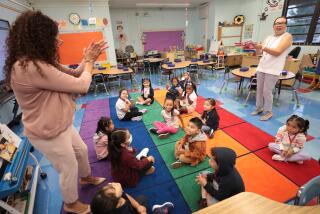Davis Proposes Longer Year for Middle Schools
- Share via
SACRAMENTO — Gov. Gray Davis is proposing that the state’s more than 1 million middle school students spend an extra six weeks in class each year in an attempt to bolster lackluster test scores, administration officials said Saturday.
The $1.45-billion plan would be phased in over three years and extend the school year from 180 days to 210 days and will be included in Davis’ 2001-2002 budget set for release Wednesday.
The proposal--greeted with skepticism by some educators and a lukewarm response from legislative leaders--represents the second education-related proposal that Davis aides have released in recent days in an effort to build support for the governor’s budget. The spending plan is sure to top $100 billion and must be approved by the Legislature.
Last week, officials outlined education initiatives totaling $380 million to attract and retain algebra teachers and establish a new teacher training program.
Administration officials, speaking on the condition that they not be identified, said the governor’s latest idea was born out of concern that middle school students in grades six through nine have been passed over by key reforms such as class size reduction implemented in lower and upper grades.
Classes of 35 to 42 students are not uncommon in middle schools, which is where officials say test scores falter. The theory floated by officials Saturday is that giving teachers more time to teach middle school curricula will aid students in achieving tough academic standards approved by the state in 1998.
Officials said extending the school year could improve students’ test scores 50% above their performance expectations. The state would give districts $770 per student--a 17% funding increase to cover teacher salaries, utilities and other expenses--as an incentive to participate in the nonmandatory program.
Wayne Johnson, president of the California Teachers Assn., said although his members might feel good that Davis wants to spend more money on schools, it remained unclear how the latest proposal would be implemented. He predicted a serious problem in squeezing the additional days in at year-round schools.
“I don’t know where you’re going to find six extra weeks because schools are in session almost every day now,” Johnson said.
Johnson also questioned whether extending the school year would contribute to teacher burnout and intensify attendance problems for low-performing students. He added that another new Davis plan, which would tack on as many as three weeks of training for teachers, could result in nine extra workweeks when combined with the extended school year proposal.
Advocates of improved teacher training such as Irvin Howard, an education professor at Cal State San Bernardino and president of the California League of Middle Schools, was critical of Davis’ latest proposal.
“What [Davis] wants to do is keep kids in school 30 more days in situations that are pretty unbearable,” Howard said. “It only frustrates kids and teachers even more.”
State Senate leader John L. Burton (D-San Francisco) said although he suspects more factors contribute to poor test scores than the number of days spent in class, he is willing to consider the governor’s proposal.
“It’s something that’s worth looking at,” Burton said. “Whether it’s the end-all is something that the [legislative] committees will have to determine.”
The state last lengthened the school year in 1983, when the number of instructional days was increased from 175 to 180. According to data released by Davis aides, California already has one of the longest school years in the nation.
Davis proposes phasing in the new program over three years by spending $100 million in the first year for 130,000 students, $450 million in the second year for 600,000 students and $900 million or more for all 1.1 million students.
More to Read
Sign up for Essential California
The most important California stories and recommendations in your inbox every morning.
You may occasionally receive promotional content from the Los Angeles Times.













